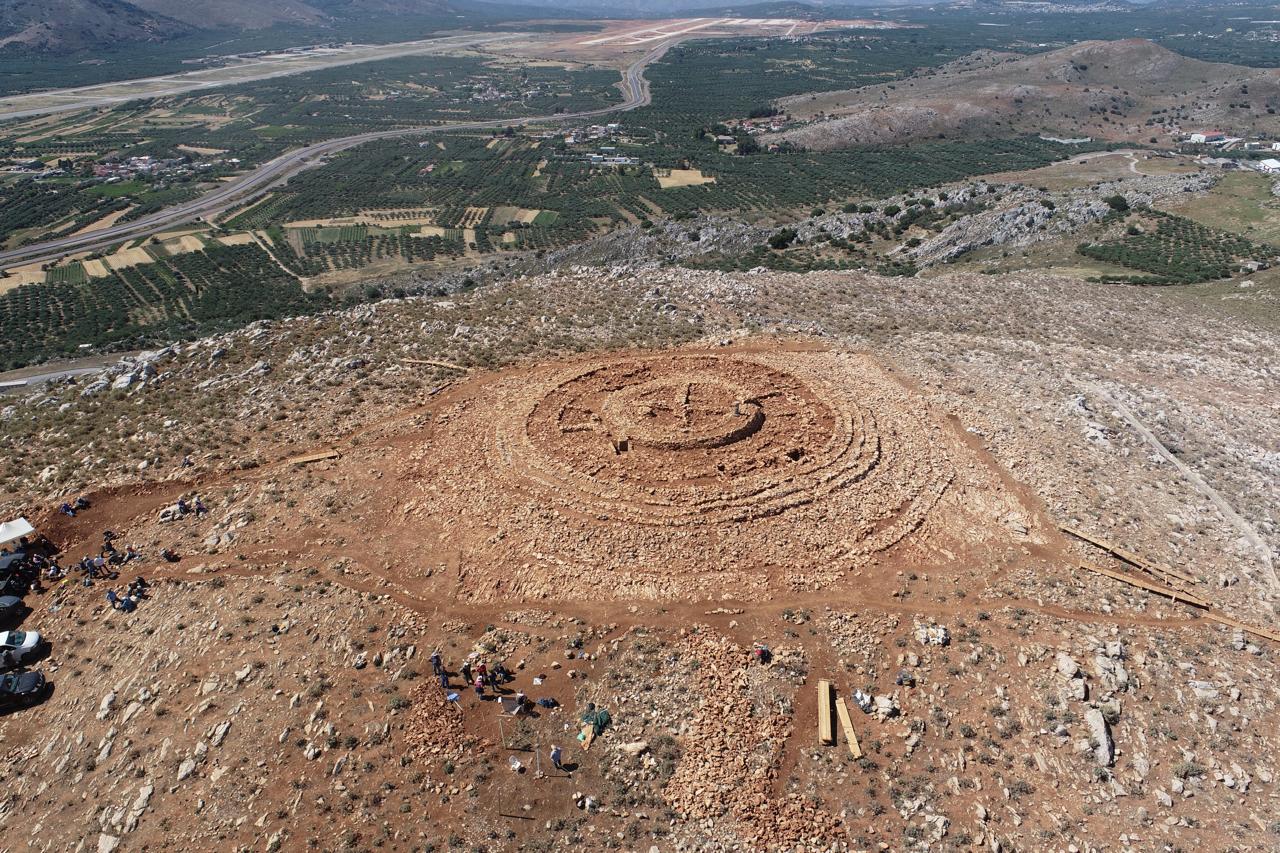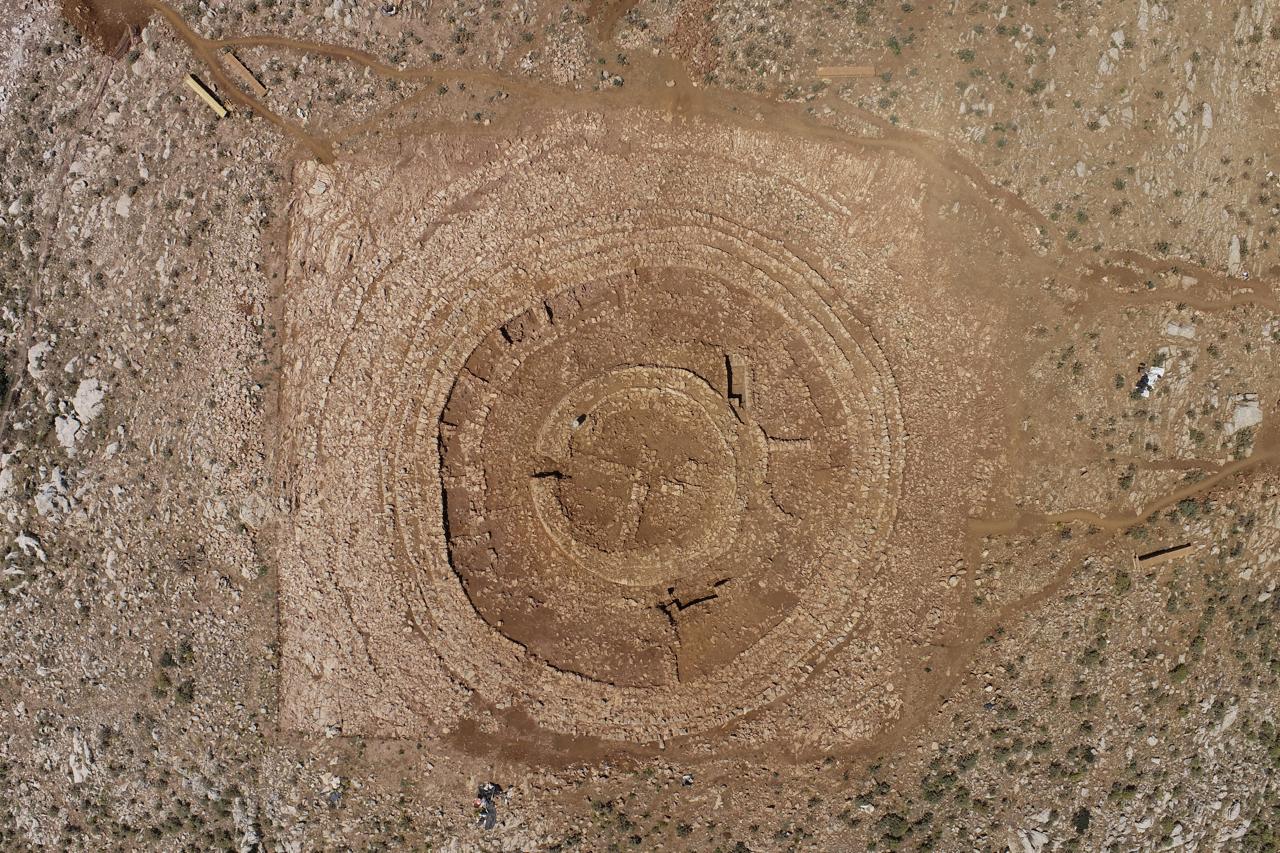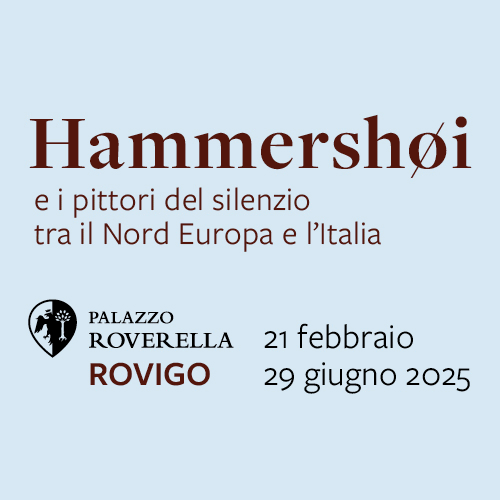Greece, exceptional discovery in Crete: a unique building resembling a labyrinth
Important discovery in Greece where, as a result of archaeological excavation activities for the construction of a radar system for the new international airport at Candia (Heraklion) on the island of Crete, a monumental architectural complex with a circular shape, believed to be unique to Minoan archaeology, has been discovered. The remains of the building were found on Papoura Hill, at an altitude of 494 meters, near the town of Kastelli, a short distance from Heraklion. The building measures about 48 meters in diameter, covers an area of about 1,800 square meters, and is located on the highest point of the hill, in a part of the summit that was expropriated for the installation of surveillance systems for the new airport.
This monumental construction consists of eight stacked stone rings (average thickness 1.40 m, and estimated maximum surviving height 1.7 m), developed at different elevations. The rings form in the center a circular building (zone A) 15 m in diameter, the interior of which (9 m in diameter) is divided into 4 quadrants. Zone A is surrounded by a second main zone (zone B, maximum width 6.9 m), in which radial walls vertically intersect the rings of the lower levels, forming smaller spaces. As the excavation proceeds, a structure resembling the shape of a labyrinth comes to light, as the spaces communicate with each other through narrow openings. Two possible main entrances to the central areas were identified on the southwest and northwest sides. The main period of use appears to be between 2000 and 1700 BC.

To evaluate the finding and plan for the continuation of the airport construction project, a large meeting was held at the construction site of the airport under construction with the participation of all parties involved, under the leadership of Culture Minister Lina Mendoni and Deputy Minister of Infrastructure and Transport Nikos Tachiaos. During the meeting, Lina Mendoni clarified that the excavation must continue so that archaeologists can interpret it, and of course preserve it given its uniqueness. As the culture minister stressed, obviously the airport construction work must continue without interruption, but the find must also be protected. This translates into the search for another suitable location for the placement of the radar. The two ministers agreed that in the near future the Civil Aviation Service will prepare and submit a new study on the location of the radar to the Ministry of Defense.
At the end of the presentation, Minister Mendoni stated the following: “This is a unique find of great interest. There are solutions so that the archaeological research of the monument will be completed and it will be fully protected. We have very good cooperation with the Ministry of Infrastructure and Transport and the responsible deputy minister Nikos Tachiaos. We have concluded an extensive meeting with all those involved: the relevant Superintendency of Antiquities in Heraklion and the relevant Directorates of Prehistoric and Classical Antiquities and Restoration of Ancient Monuments of the Ministry of the Interior, and the relevant departments of the Ministry of Infrastructure, the Civil Aviation and the contractor. The priority of all of us is the protection of the monument, of this unique artifact. We all understand the importance and value of cultural heritage. We all understand the dimension of the development of the specific project, which is carried out in Kastelli. The new airport project can proceed and the antiquities can be protected, as it should be.”
As excavation research is still ongoing at present, it is not possible to determine the original form or the overall height of the structure for the time being. The buildings in the central zone, as indicated by the construction system, were probably truncated cone-shaped or vaulted. The two zones A and B formed by the upper rings appear to be the main focus of the building. The quantity and type of finds, as well as the presence of a large amount of animal bones, do not suggest, at least to date, permanent habitation use, but probably periodic use in the form of rituals that may have occurred, involving the consumption of food, wine, and perhaps offerings. This is the first such monument that has been identified and excavated in Crete. What is certain is that it is a kind of community building, a landmark for a large territory. The fact that the structure is monumental and prominent probably indicates the importance of the place, but also the segment of the population for which it was perhaps intended.

The plan of the monument and the structure of the areas and spaces as revealed so far, but also the entire construction, do not have exact parallels with other coeval buildings in Crete, although as a form it is not entirely unfamiliar since we know of similarly shaped Early Bronze Age architectural complexes in the Middle East. It can perhaps be paralleled with the MM elliptical building at Hamaizius, as well as with the so-called circular proto-Hellenic cyclopean building at Tiryns. However, structural similarities are also found with the so-called vaulted tombs of the pre-Palazitic and Paleopalazitic periods of southern Crete.
The Ministry of Culture of Greece considers it necessary to complete research in order to clarify the character of the monument and its relationship to residential and religious centers of the same period in the area on which it stands. The monumentality of the building, as well as the fact that nothing similar has been unearthed so far, make it an exceptional find.
 |
| Greece, exceptional discovery in Crete: a unique building resembling a labyrinth |
Warning: the translation into English of the original Italian article was created using automatic tools. We undertake to review all articles, but we do not guarantee the total absence of inaccuracies in the translation due to the program. You can find the original by clicking on the ITA button. If you find any mistake,please contact us.
































